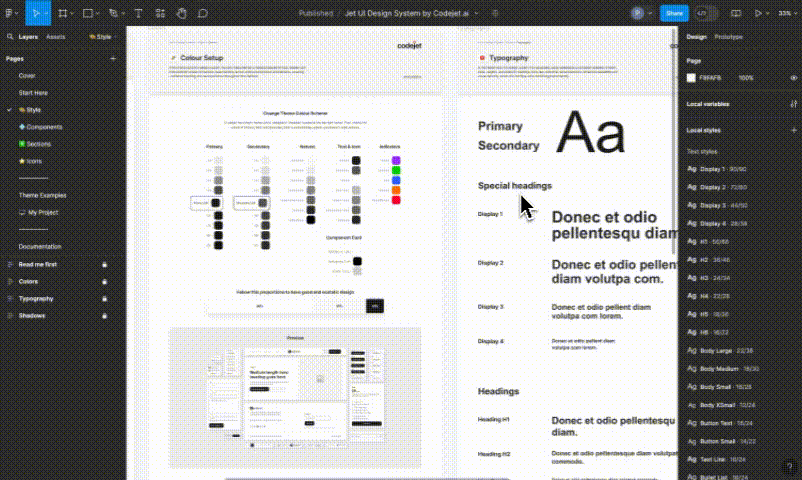Converting Figma designs to React components is soul-crushing work. You spend hours measuring pixels, copying CSS values, and building components that look exactly like what the designer already created. It's the kind of work that makes you question your career choices.
I've been testing Codejet extensively on real projects, and here's what you actually get when the marketing bullshit is stripped away.
Code Generation Quality

Unlike other tools that just shit out absolute-positioned divs, Codejet actually tries to build proper React components. The generated code uses CSS Flexbox layouts and creates actual component hierarchies with TypeScript interfaces.
What you get:
- CSS flexbox instead of position: absolute hell
- Actual component hierarchy that makes sense
- Media queries (though they break on real phones)
- Files organized like a human might structure them
The code looks like what a decent junior dev might write - it compiles and works, but you'll spend time cleaning it up. Still beats manually converting every damn pixel from Figma.
Code Quality and Cleanup Requirements

The generated code compiles, but good luck shipping it without cleanup. Here's what actually breaks:
CSS Disasters:
- Responsive breakpoints work in Chrome preview, fail spectacularly on iPhones
- Z-index wars everywhere - generated
z-index: 999like it's 2010 - Hover states? What hover states? Your buttons are dead fish
- Spacing is off by 2-4 pixels from the design (designers notice this shit)
TypeScript Garbage:
- Everything typed as `any` - might as well be JavaScript with comments
- Interface definitions that validate nothing:
props: any - Enable strict mode and watch 47 errors appear on a simple button component
- Import statements that make no sense:
import React, { Component } from 'react'for functional components
React Anti-Patterns:
- No state management beyond `useState` - good luck with complex forms
- Event handlers that just log to console:
onClick={() => console.log('clicked')} - Zero accessibility - screen readers will hate you
- No memoization, no optimization - your bundle analyzer will weep
Stability and Reliability Concerns
Codejet calls itself "alpha software" which is corporate speak for "expect it to break constantly." Here's what I've experienced:
Plugin Crashes From Hell:
- Plugin crashes every 15-20 exports - you'll restart Figma more than your computer
- Sometimes exports just... stop. No error, no feedback, just eternal loading
- `TypeError: Cannot read property 'children' of undefined` - their plugin doesn't handle empty frames
- Lost 3 hours of work when it crashed mid-batch and corrupted the component tree
Their Website is Broken:
- Pricing page returns 404 half the time
- Account dashboard loads for 30 seconds then times out
- Tried to upgrade my plan during crunch time - payment failed, support took 2 days to respond
Code That Lies to You:
- Components look perfect in Figma, compile fine, then crash when users click them
- Generated a login form that worked until you entered a password longer than 8 characters
- Variable names like
component1,container2- debugging is like solving puzzles blindfolded - Spent 4 hours tracking down why a button worked everywhere except production (missing event handler)
What Actually Works:
- Export 3-5 components max at once or it shits the bed
- Commit the garbage immediately before touching it - you can't regenerate after modifications
- Keep manual backup ready - I've missed deadlines because this tool failed during demos
Business Continuity Concerns

The company behind Codejet is pivoting to something called mysite.ai, which is startup speak for "we're abandoning this product to chase the next shiny thing." This is a massive red flag.
The Death Spiral:
- No roadmap updates in 6+ months
- Support tickets get generic "we're focusing on our new product" responses
- Bug reports sit in their Discord for weeks with no developer response
- Last major update was in early 2024 - everything since has been maintenance patches
What This Means For You:
Building your workflow around Codejet is like building on quicksand. When (not if) they shut it down, you're left with whatever code you've already generated - no more exports, no updates, no bug fixes.
I learned this lesson with Atomic Design tools that disappeared overnight. Don't make the same mistake.
Appropriate Use Cases
Despite all the bullshit, Codejet actually works for specific situations:
Where It Doesn't Suck:
- Landing pages with simple grid layouts (no complex interactions)
- Marketing sites where "close enough" beats spending 3 days hand-coding
- Quick prototypes when you need something working in 2 hours, not 2 days
- Component library scaffolding (generate basic structure, then rebuild properly)
Where It Will Ruin Your Life:
- Anything requiring pixel-perfect precision - designers will revolt
- Complex forms with validation, animations, or custom interactions
- Production apps where code quality matters more than delivery speed
- Projects using styled-components, emotion, or any custom CSS-in-JS setup
- Anything with accessibility requirements beyond "it has semantic HTML"
Recommended Implementation Workflow
If you're going to use this broken tool anyway, here's how to minimize the pain:

Before You Start (Save Yourself Time Later):
- Use their Jet UI components when possible - they actually export correctly
- Don't overlap elements - the AI gets confused and generates positioning hell
- Simplify complex layouts or you'll spend more time fixing than building from scratch
The Export Dance:
- Export 3-5 components max - any more and it crashes
- Git commit the raw garbage immediately (you can't regenerate after changes)
- Test that it compiles before celebrating - half the time it doesn't
Reality Check Phase:
- Enable TypeScript strict mode and fix the 20+ errors
- Test on real phones, not Chrome's device preview (spoiler: it breaks)
- Budget 2-3 hours cleanup time per "simple" component
When It All Goes Wrong:
The plugin crashes? Restart Figma, clear cache, sacrifice a goat, try again with simpler designs. Sometimes it just refuses to work and you have to code manually anyway.
Evaluation Summary
The Brutal Truth:
Codejet saves time upfront but costs time on cleanup. For simple components, you might break even. For complex ones, you'll wish you hand-coded from the start.
Time Reality Check:
- Simple button: 15 minutes saved, 30 minutes cleanup = net loss
- Landing page hero section: 2 hours saved, 1 hour cleanup = win
- Complex form: 4 hours "saved", 6 hours fixing = epic fail
The Real Risks:
- Company's dying: They're pivoting away - tool will be abandoned
- Code is technical debt: You'll rewrite most of it eventually
- Reliability is garbage: Don't use this for client demos or tight deadlines
My Recommendation:
Use Codejet for throwaway prototypes and marketing pages where "good enough" is actually good enough. Don't build your development workflow around it - when it inevitably shuts down, you'll be fucked.
For anything that matters, bite the bullet and code it properly. Your future self will thank you when you're not debugging mysterious crashes at 3am because some AI generated garbage that barely worked.